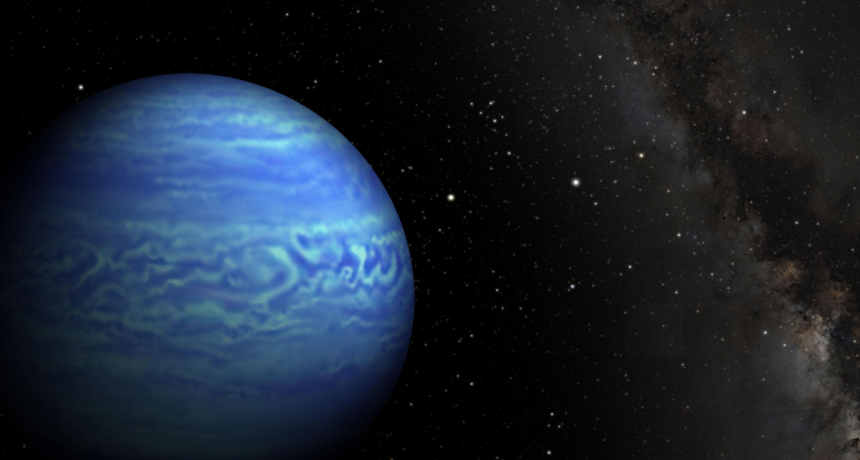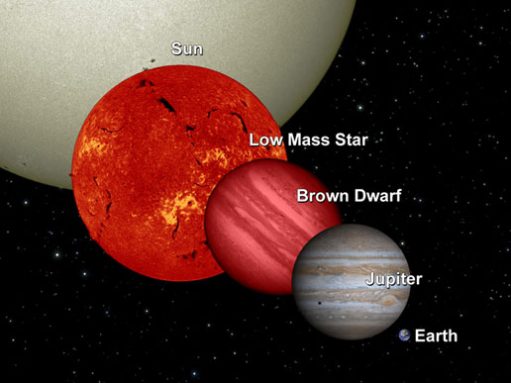Failed ‘star’ found in sun’s backyard
Called a brown dwarf, NASA says it’s ‘as frosty as Earth’s North Pole’

Artists’ rendering of the newfound wannabe-star, the coldest-known brown dwarf.
By Janet Raloff
Some starlets aren’t so hot. Consider the brown dwarf that was just found 7.2 light-years from our sun. NASA reported the discovery of this object on April 25. The failed star has a downright frosty temperature, somewhere between -48º and -13º Celsius (-54º to 9º Fahrenheit).
Like regular stars, brown dwarfs begin as balls of gas. Over time, gravity causes that gas to condense into a tight mass. In a star like our sun, the mass of condensed gas drives fusion — the nuclear reaction that releases huge quantities of energy and light. But in a brown dwarf, that mass of is too small to sustain fusion. So these star-wannabes remain dim.
The newfound brown dwarf is the coldest and one of the smallest discovered to date. Astronomers estimate that it’s only 3 to 10 times as massive as Jupiter. And as the fourth closest starlike object to our sun, it’s practically in the solar system’s backyard.
“It’s very exciting to discover a new neighbor of our solar system that is so close,” says Kevin Luhman. He’s an astronomer at Pennsylvania State University’s Center for Exoplanets and Habitable Worlds, in University Park. “Given its extreme temperature,” he says, this celestial object “should tell us a lot about the atmospheres of planets, which often have similarly cold temperatures.”

Astronomers have named the newfound dwarf WISE J085510.83-071442.5. The first part of its name comes from the space telescope that spied it: WISE, which stands for NASA’s Wide-field Infrared Survey Explorer.
WISE surveyed the entire sky twice in infrared light. Some regions were even surveyed three times. Brown dwarfs would be invisible to telescopes that scan the skies for visible-light emissions. But their feeble glow stands out in the infrared range of light. And in the WISE survey, several scans turned up the newfound dwarf — in different spots in the sky. That indicated it was moving rapidly.
“This object appeared to move really fast in the WISE data,” says Luhman. “That told us it was something special.”
After recognizing this speedy movement in March 2013, Luhman spent time analyzing additional images taken by other telescopes. Infrared data from NASA’s Spitzer Space Telescope helped him figure out the brown dwarf’s temperature. By combining data from WISE and Spitzer, Luhman’s team established its distance.
“It is remarkable that even after many decades of studying the sky, we still do not have a complete inventory of the sun’s nearest neighbors,” says Michael Werner. He’s the project scientist for Spitzer at NASA’s Jet Propulsion Laboratory in Pasadena, Calif. “This exciting new result demonstrates the power of exploring the universe using new tools, such as the infrared eyes of WISE and Spitzer.”
Power Words
asteroid A rocky object in orbit around the sun. Most orbit in a region that falls between the orbits of Mars and Jupiter. Astronomers refer to this region as the asteroid belt.
astronomy The area of science that deals with celestial objects, space and the physical universe as a whole. People who work in this field are called astronomers.
brown dwarf A would-be star that never became massive enough to sustain nuclear fusion and burn brightly.
celestial object Any naturally formed objects of substantial size in space. Examples include comets, asteroids, planets, moons, stars and galaxies.
fusion The merging of two things to form a new combined entity. (in physics) The process of forcing together the nuclei of atoms. This nuclear fusion is the phenomenon that powers the sun and other stars, producing heat and forging the creation of new, larger elements.
galaxy A massive group of stars bound together by gravity. Galaxies, which each typically include between 10 million and 100 trillion stars, also include clouds of gas, dust and the remnants of exploded stars.
gravity The force that attracts anything with mass, or bulk, toward any other thing with mass. The more mass that something has, the greater its gravity.
infrared light A type of electromagnetic radiation invisible to the human eye. The name incorporates a Latin term and means “below red.” Infrared light has wavelengths longer than those visible to humans. Other invisible wavelengths include X rays, radio waves and microwaves.
Jupiter (in astronomy) The solar system’s largest planet, it has the shortest day length (10 hours). A gas giant, its low density indicates that this planet is composed of light elements, such as hydrogen and helium. This planet also releases more heat than it receives from the sun, as gravity compresses its mass (and slowly shrinks the planet).
light-year The distance light travels in a year, about 9.48 trillion kilometers (almost 6 trillion miles). To get some idea of this length, imagine a rope long enough to wrap around the Earth. It would be a little over 40,000 kilometers (24,900 miles) long. Lay it out straight. Now lay another 236 million more that are the same length, end-to-end, right after the first. The total distance they now span would equal one light-year.
mass A number that shows how much an object resists speeding up and slowing down — basically a measure of how much matter that object is made from.
planet A celestial object that orbits a star, is big enough for gravity to have squashed it into a roundish ball and it must have cleared other objects out of the way in its orbital neighborhood. To accomplish the third feat, it must be big enough to pull neighboring objects into the planet itself or to sling-shot them around the planet and off into outer space. Astronomers of the International Astronomical Union (IAU) created this three-part scientific definition of a planet in August 2006 to determine Pluto’s status. Based on that definition, IAU ruled that Pluto did not qualify. The solar system now consists of eight planets: Mercury, Venus, Earth, Mars, Jupiter, Saturn, Uranus and Neptune.
solar system The eight major planets and their moons in orbit around the sun, together with smaller bodies in the form of dwarf planets, asteroids, meteoroids and comets.
star Thebasic building block from which galaxies are made. Stars develop when gravity compacts clouds of gas. When they become dense enough to sustain nuclear-fusion reactions, stars will emit light and sometimes other forms of electromagnetic radiation. The sun is our closest star.
telescope A light-collecting instrument that makes distant objects appear nearer through the use of lenses or a combination of curved mirrors and lenses. Some, however, collect radio emissions (energy from a different portion of the electromagnetic spectrum) through a network of antennas.
Wide-field Infrared Survey Explorer (abbreviated WISE) A space telescope launched by NASA in December 2009 to survey the skies for infrared light emissions. It only had enough of a chilling chemical onboard, needed to keep the telescope from obscuring very cold objects to last a little more than a year. It completed its sky surveys in early 2011.







